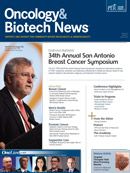Publication
Article
Oncology & Biotech News
Radiation Added to Hormone Therapy Bests Hormone Therapy Alone for High-Risk Prostate Cancer
Author(s):
Radiation therapy added to androgen deprivation therapy prolongs overall survival in men with locally advanced or otherwise high-risk prostate cancer.
Padraig Warde, MD
Radiation therapy (RT) added to androgen deprivation therapy (ADT) prolongs overall survival (OS) in men with locally advanced or otherwise high-risk prostate cancer, according to interim results of a phase III study.
“Our findings suggest that the benefits of the combination of ADT and RT should be discussed with all patients considering a curative treatment approach,” said Padraig Warde, MD, with Princess Margaret Hospital in Toronto, Canada, and co-authors.
The team randomized 1205 patients to lifelong ADT alone or ADT and RT (ie, 65 to 69 Gy to the prostate and seminal vesicles, and 45 Gy to the pelvic nodes).
Study participants had locally advanced (T3 or T4) prostate cancer or organ-confined disease (T2) with either a prostate-specific antigen (PSA) concentration more than 40 ng/mL or a PSA concentration more than 20 ng/mL and a Gleason score of 8 or higher.
Prostate cancer is the most frequently diagnosed cancer in men in the United States; it ranks second after lung cancer in cancer-related mortality. The percentage of patients who present with locally advanced disease at diagnosis has fallen over the past couple of decades primarily due to the popularity of PSA screening. Even so, locally advanced disease remains common, with no consensus on its optimal management.
The primary outcome measure in the present study was OS. A preplanned interim analysis was conducted when two-thirds of the events for the final analysis were documented.
The addition of RT to ADT improved OS at 7 years to 74% (95% CI, 70-78) versus 66%, (hazard ratio [HR] 0.77; 95% CI, 0.61-0.98; P = .033).
Cancer-specific survival improved by 10% in absolute terms in the RT plus ADT group and by 46% (HR, 0.54; 95% CI, 0.22-0.73; P = .0001) in relative terms compared with solo ADT.
Serious long-term genitourinary or gastrointestinal toxicity from radiation therapy was uncommon.
Warde and colleagues pointed out that theirs is the first study that is sufficiently powered to examine RT plus ADT versus ADT alone in locally advanced prostate cancer patients in which eligibility did not depend on prognostic factors. They noted that study strengths include randomization and a large sample size. However, the cause of death was assessed by the local investigator, and bias may have been introduced into the disease-specific survival endpoint because treatment allocation was not blinded. Also, the study did not obtain data on skeletal adverse events because the importance of bone health in ADT-treated patients was not recognized at the start of the trial.
In their final analysis, they plan to tabulate multivariate risk scores for all patients to confirm that the risk is essentially the same in the 2 treatment arms. They also plan to examine whether outcomes differ when patients are stratified by their baseline risk.
Warde P, Mason M, Ding K, et al. Combined androgen deprivation therapy and radiation therapy for locally advanced prostate cancer: a randomised, phase 3 trial [published online ahead of print November 2, 2011]. Lancet. 2011;378(9809):2104-2111.










